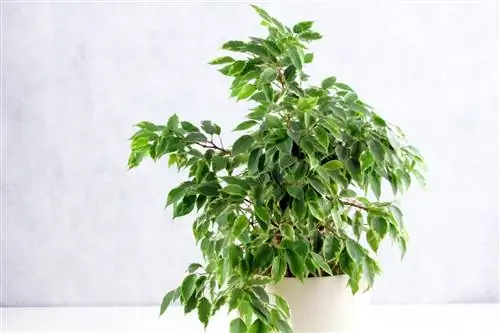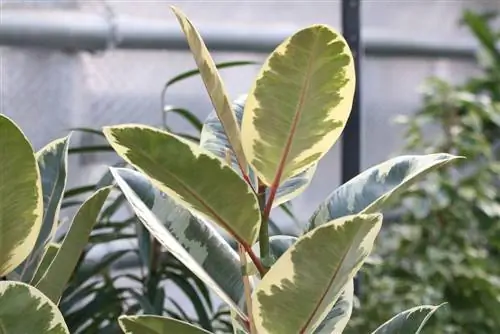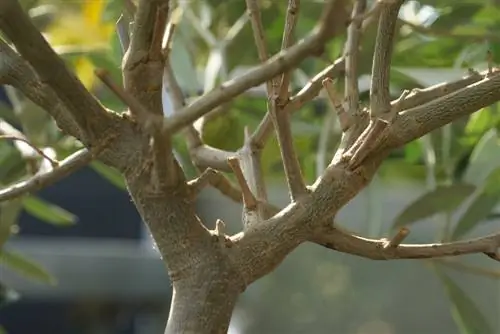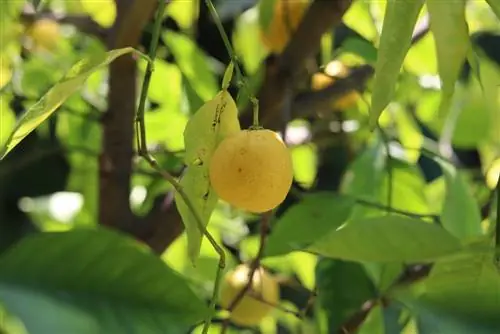- Author admin [email protected].
- Public 2023-12-17 03:39.
- Last modified 2025-01-24 12:45.
As long as a lemon tree is pampered with sunshine in the summer garden, it will wear its shiny green foliage, sometimes even in sync with its fragrant flowers and yellow fruits. Things become critical for the Mediterranean ornamental tree in winter, which often results in all the leaves being shed. In order for the floral jewel to shine again in its former beauty, a competent analysis of the causes is important. Read here why leaves fall in the first place. Use our recommendations on what measures you can take to get your lemon tree back in shape.
Knowledge of botany makes it easier to find the cause
A quick excursion into the botany of Citrus limon makes it clear why it sheds its leaves. Anyone who becomes a little familiar with the most important aspects of their growth behavior will find it much easier to analyze the causes and resolve them. Then it becomes clear why this damage occurs primarily during the winter.
As an evergreen plant, a he althy lemon tree only occasionally sheds its oldest leaves to make room for young foliage and to gradually rejuvenate itself. However, if there is a significant amount of leaf shedding, the balance between roots and leaves is disturbed. Both parts of the plant fulfill different functions that must be coordinated with one another so that the citrus plant thrives.
The leaves absorb light, carbon dioxide and water to produce starch and oxygen for vital growth. To ensure that this process of photosynthesis runs smoothly, the foliage is supplied with water and nutrients by the roots. The water also has the task of cooling the leaf surface through evaporation. As long as this cycle works smoothly, every leaf stays in its place.
Reasons for leaf shedding at a glance
If the delicate process between leaves and roots becomes unbalanced, the only option available to a lemon tree is to shed the leaves in order to restore balance on its own. By taking appropriate measures to help your Mediterranean gem, leaf fall can be avoided. To this end, the causes of the imbalance must be eliminated. The following 5 reasons cause the problem:
- Lack of light
- Dry air
- Water shortage
- Waterlogging
- Subcooled root ball
Specifically, it is the unnatural site conditions that a lemon tree has to cope with as a container plant far away from its southern home. This is proven by the fact that citrus plants planted in their Mediterranean habitats only lose their leaves in rare exceptional cases.
The causes in detail

In order to get your lemon tree fit again, the general conditions at the location are checked for the causes mentioned. Below we will examine each trigger for the problem in detail and explain how you can help your Citrus limon regain its magnificent leaves.
Cause: lack of light
Solution: Additional lighting with plant lamps
The most common cause of a lemon tree without leaves is a lack of light. This problem occurs when there is insufficient light at high temperatures. That sounds plausible, since a lemon tree in full sun on the summer balcony doesn't think about shedding its leaves. However, due to the low light intensity in winter, the plant uses more energy than it can generate through photosynthesis. Since photosynthesis does not work without light, the lemon responds to the imbalance by reducing its leaf volume. How to solve the problem:
- If temperatures exceed 10 degrees Celsius in the winter quarters, provide additional lighting for the crown
- Use a plant lamp with 14 to 15 watts and a blue-red light spectrum
- Ideally purchase a lamp with a shade and reflector coating
- Ensure a daily lighting duration of 8 hours
The plant lamp is hung so that there is a distance of 100 cm between the crown of the lemon tree and the lampshade. If there are additional light sources nearby, such as a daylight window, the lighting time can be reduced.
Tip:
A lemon tree in the warm, illuminated winter quarters continues to grow. Therefore, the need for water and nutrients increases. The need for watering can be controlled using a moisture meter. A liquid citrus fertilizer is added to the irrigation water every 4 to 6 weeks, but only when the crown has leaves again.
Cause: Dry air
Solution: Increase humidity
Where there is no bright, cool winter quarters available, hobby gardeners are forced to move their lemon trees into the living room in autumn. In this location it is not enough to compensate for the lack of light with a plant lamp. When the heating season begins at the latest, the humidity in the room drops and the leaves fall off. By increasing the local humidity with the following measures, you can get your Citrus limon back in shape:
- Fill the coaster with expanded clay and water
- Set up a humidifier in the immediate vicinity and let it run continuously
- Hang the water vaporizer on the radiators and fill it up regularly
- Spray the crown regularly with room temperature water
Place the lemon tree as far away as possible from the active radiators. If there is an aquarium or indoor fountain next to it, the lemon benefits from the higher humidity.
Cause: lack of water
Solution: Dip and now water using a moisture meter
One of the biggest challenges in the successful care of citrus plants is correct watering. While in summer the daily thumb test is sufficient to estimate the current water requirement, this does not apply to the tricky winter time. Since care instructions always point out that the winter should be kept as dry as possible, concerned hobby gardeners do not water enough. Due to the resulting dryness of the ball, all leaves fall off. As an immediate measure, immerse the dried root ball in a bucket of soft water until no more air bubbles appear.

Since the finger test in the winter quarters does not provide satisfactory information about the moisture content in the root ball, the use of a special measuring device ensures clarity. After diving has resolved the acute lack of water, you can now rely on mechanical support for professional watering. This is how it works:
- Buy a moisture meter for potted plants
- Place the device into the substrate like a thermometer
- After a short wait, pull the knife out again and read it
A simple device works without a battery and displays the result on a scale from 1 to 8. A value of 1 to 2 means dryness, so watering is required. If the scale is between 3 and 5, you can cast. In the range from 6 to 8 the root ball is still saturated with water.
Cause: waterlogging
Solution: Repotting and reduced watering
If the root ball was soaked by the abundant autumn rain before being cleared away, the water can no longer evaporate in the winter quarters. The resulting waterlogging causes the roots to rot, so that the supply of water and nutrients to the leaves comes to a standstill. In its distress, the lemon tree sheds its leaves completely. Last but not least, home gardeners cause waterlogging by being too careful with their water supply. If you can identify a waterlogged root ball as the cause, you can get the lemon back in shape by immediately repotting it in fresh soil. How to proceed:
- Unpot the lemon tree to completely remove the wet soil from the root ball
- Cut off rotten, softened roots with a sharp, clean knife
- Clean the bucket and let it dry
- Spread pottery shards, grit or expanded clay on the floor as drainage
- Place a breathable, rot-proof fleece over it
- Pour fresh citrus soil up to half the height of the pot
Now pot the root ball so deeply that it returns to the previous planting depth. Pour the fresh, dry soil into the cavities in portions and repeatedly tap the pot so that it is better distributed. If the container is too heavy for this, press the substrate lightly with your fist or a wooden stick. Use a moisture meter to check when the root ball has dried out enough to be watered again.
Tip:
Once the problem of leaf drop on a lemon tree has been solved, it requires a long process of patience until new leaves sprout. Even under ideal conditions, several weeks will pass before the hoped-for result occurs.
Cause: Hypothermic root ball
Solution: Water with warm water or dark places
Scientific studies have shown that the roots of a lemon tree stop working at a temperature below 12.5 degrees Celsius. This would not be a problem in the winter quarters if the leaves in the bright location did not warm up well above this mark. Leaf activity in the form of photosynthesis continues without the roots supplying supplies of water and nutrients. To correct this imbalance, the citrus plant sheds its leaves. The following options are available to solve the problem:
- Measure the temperature in the root ball with a thermometer
- At 12.5 degrees Celsius or lower, water immediately with tempered water at 25 degrees Celsius
- Alternatively, move the lemon tree to a darker location
- Warm the root ball to 21 degrees Celsius with a heating mat in a still bright location
Whatever option you choose; implementation should take place gradually. A Citrus limon always reacts angrily to abrupt changes in the current conditions, so that the hoped-for leaf growth takes longer to arrive than under normal conditions. If a supercooled root ball turns out to be the cause of the leaf fall, the lemon tree will recover quickly in spring. However, this only applies if you water the plant moderately and protect it from waterlogging.
Is the leafless lemon tree still alive?
It only takes time for a lemon tree to decide to produce new shoots. Experience has shown that the new leaves only flourish at the beginning of the next growing season. Until then, the ornamental tree presents itself with a crown of seemingly dead branches and no signs of budding. Now you are right to ask yourself whether it is worth the effort to get the plant fit again.

With a simple vitality test you can determine whether there is still life in your leafless lemon tree. This checks whether the pathways in the tree are still active and transport water from the roots to the crown. Since the channels are located directly under the bark, simply scrape a little of it off. If lush greenery appears, the branch is still alive. However, if woody, brown material appears, at least this shoot has died. Carry out this test on all branches if possible. As long as at least a third still has green tissue, there are good prospects of new leaves. Cut the dead branches back to he althy wood.
Tips for prevention
So that your lemon tree doesn't end up without leaves at the end of winter, you can take various preventive measures in advance. Ideally, there is an orangery near you that offers a wintering service for citrus plants. Here you can be sure that you will get your lemon tree back with a dense foliage in spring. Where this option does not exist, a winter quarter should be sought that has the following characteristics:
- Cool temperatures around 10 degrees Celsius and partially shaded, not too bright lighting conditions
- Avoid wintering at room temperature and light below 2,600 lux
- Rule of thumb: The cooler, the darker - the warmer, the brighter
- Water only a little and do not fertilize
Perfect for a wintering lemon tree is a winter garden that is only heated when necessary to maintain the balance between temperature and light. However, if this winter garden is used as an extended living space and is heated accordingly, the leaves will fall off. In this case, specialist retailers offer large winter tents, equipped with frost monitors and fan heaters. The temperature is controlled with a digital thermometer that can be connected to all heating devices. These tents have the advantage that the floor can be removed in spring. This means they function as a practical greenhouse until autumn.
If you're afraid of investing in a winter tent for your lemon tree, choose a bright, unheated stairwell or a frost-free garage with windows and a frost monitor. It should be ensured that opening the doors and windows does not create a cold draft. If a cool basement with temperatures below 15 degrees Celsius is available, an inexpensive plant lamp is sufficient for undamaged wintering.
Conclusion
Leaf falling on the lemon tree is a common phenomenon that causes headaches among amateur gardeners. The problem usually occurs in connection with the winter, as the combination of cool temperatures and low lighting conditions throws the Mediterranean ornamental tree out of balance. The most common reasons for the dilemma are lack of light, dry air, lack of water, waterlogging and a supercooled root ball. These instructions will help you analyze the causes and solve the problem so that you can get your leafless lemon tree back in shape.






